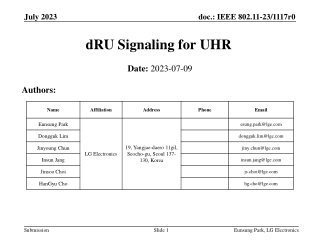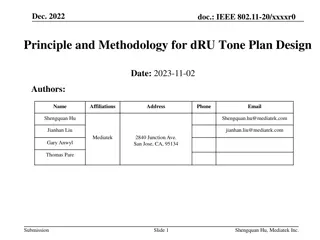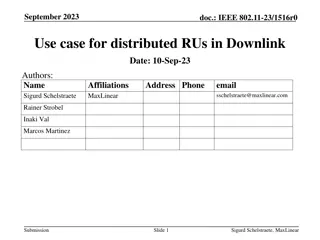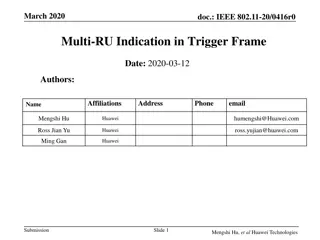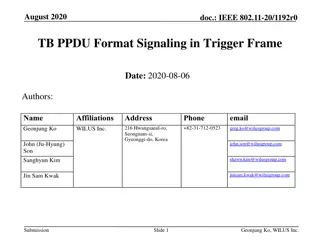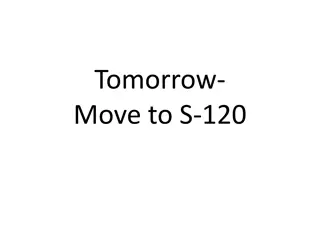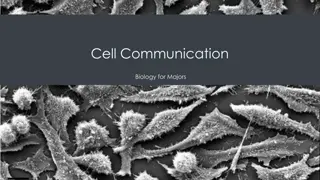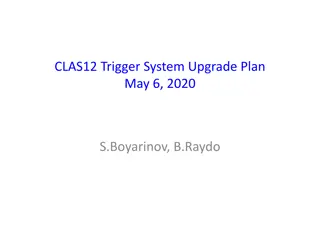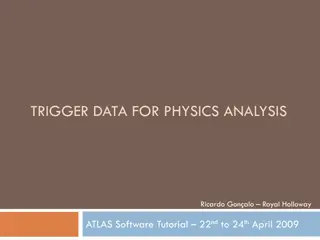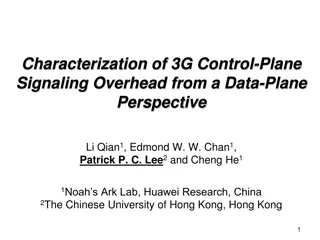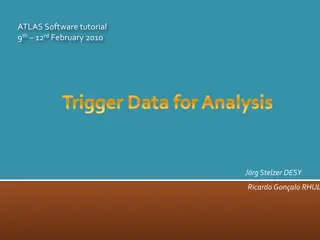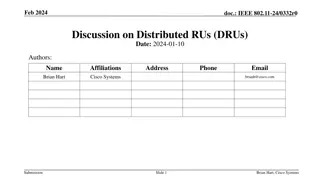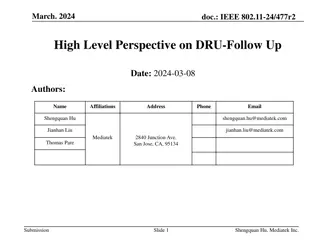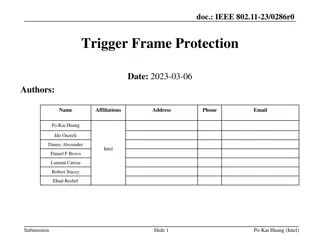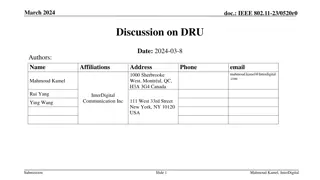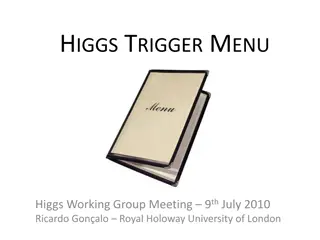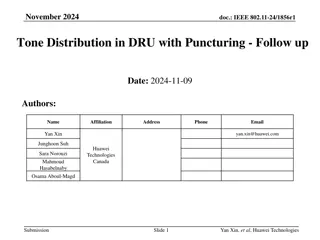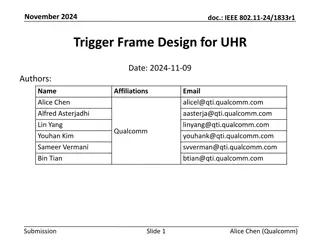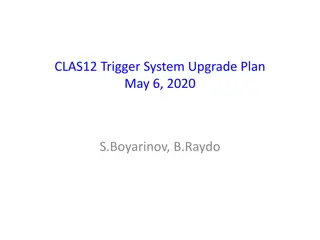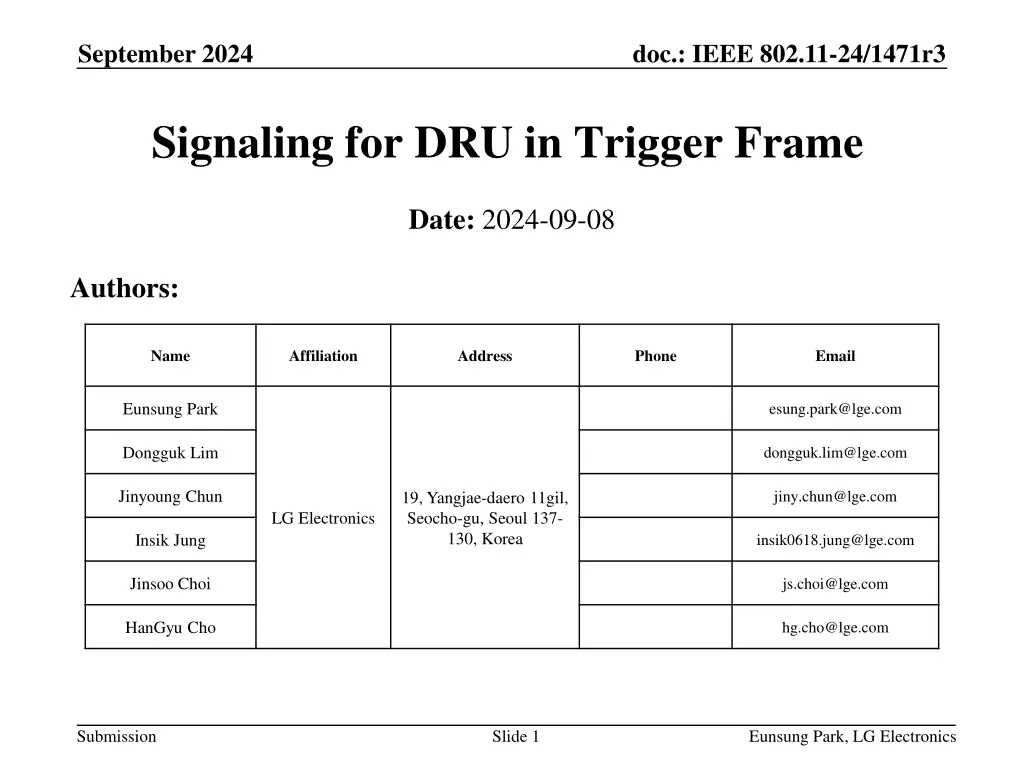
IEEE 802.11-24/1471r3 Signaling for DRU in Trigger Frame
Explore the detailed approach for signaling Durable Rate User (DRU) in the Trigger frame of IEEE 802.11-24/1471r3 document. Learn about reducing signaling overhead and introducing novel DRU signaling methods for maximizing efficiency in wireless communication standards. Discover the proposed RRU/DRU Flag and DBW Mode subfields for enhanced performance.
Uploaded on | 0 Views
Download Presentation

Please find below an Image/Link to download the presentation.
The content on the website is provided AS IS for your information and personal use only. It may not be sold, licensed, or shared on other websites without obtaining consent from the author. If you encounter any issues during the download, it is possible that the publisher has removed the file from their server.
You are allowed to download the files provided on this website for personal or commercial use, subject to the condition that they are used lawfully. All files are the property of their respective owners.
The content on the website is provided AS IS for your information and personal use only. It may not be sold, licensed, or shared on other websites without obtaining consent from the author.
E N D
Presentation Transcript
September 2024 doc.: IEEE 802.11-24/1471r3 Signaling for DRU in Trigger Frame Date: 2024-09-08 Authors: Name Affiliation Address Phone Email Eunsung Park esung.park@lge.com Dongguk Lim dongguk.lim@lge.com Jinyoung Chun jiny.chun@lge.com 19, Yangjae-daero 11gil, Seocho-gu, Seoul 137- 130, Korea LG Electronics Insik Jung insik0618.jung@lge.com Jinsoo Choi js.choi@lge.com HanGyu Cho hg.cho@lge.com Submission Slide 1 Eunsung Park, LG Electronics
September 2024 doc.: IEEE 802.11-24/1471r3 Introduction In [1], various DBW modes were proposed In [2], two approaches for DRU signaling in the Trigger frame were discussed Based on per-user indication or common indication, it proposed a subfield to indicate DBW modes In this contribution, we deal with how to reduce signaling overhead for DBW mode indication by considering a DRU signaling method in the common part To obtain further benefits, we also introduce a two-step DRU signaling To this end, we propose RRU/DRU Flag and DBW Mode subfields Slide 2 Submission Eunsung Park, LG Electronics
September 2024 doc.: IEEE 802.11-24/1471r3 Recap on DBW Modes 11bn adopted the following DBW modes for 80 MHz PPDU 80 MHz mode 20 MHz + 20 MHz + 40 MHz (or 40 MHz + 20 MHz + 20 MHz) mode In [1], various DBW modes were also proposed for 80 MHz with preamble puncturing 20 MHz + 40 MHz (or 40 MHz + 20 MHz) mode with 20 MHz puncturing 40 MHz mode with 40 MHz puncturing For 40 MHz, 20+20 MHz mode was also considered to support 20 MHz operating STAs in [1] Potential DBW modes are shown in Appendix Submission Slide 3 Eunsung Park, LG Electronics
September 2024 doc.: IEEE 802.11-24/1471r3 Approach for DRU Signaling (1/3) DRU transmission is supported in a TB PPDU, and thus, we consider detailed signaling for DRU in the Trigger frame Taking into account various PHY features and their signaling, the current User Info field may not have enough bits for DRU signaling Whereas in the Common Info field and the Special User Info field, there are many reserved bits and we can utilize some of them for DRU signaling Submission Slide 4 Eunsung Park, LG Electronics
September 2024 doc.: IEEE 802.11-24/1471r3 Approach for DRU Signaling (2/3) Also, DRU signaling is related to indicate DBW modes which are not user specific information, and thus, it may be more proper to define a relevant subfield in the common part Meanwhile, given 80 MHz based PHY processing, it is better to define a separate signaling method per 80 MHz as proposed in [2] which leads to overhead reduction In each 80 MHz channel of the Trigger frame, a DBW mode applied to the corresponding 80 MHz channel of a TB PPDU is indicated, and thus, different information can be transmitted in different 80 MHz channels Submission Slide 5 Eunsung Park, LG Electronics
September 2024 doc.: IEEE 802.11-24/1471r3 Approach for DRU Signaling (3/3) However, considering various potential DBW modes in 80 MHz, we may need a lot of bits for the DBW mode indication Potential DBW modes in 80 MHz are as follows Non-punctured cases: 80 MHz (1 case), 160 MHz (1 case), 20+20+40 MHz, 40+20+20 MHz (2 cases) Punctured cases: Pu20+20+40 MHz, 20+Pu20+40 MHz, 40+Pu20+20 MHz, 40+20+Pu20 MHz (4 cases), Pu40+40 MHz, 40+Pu40 MHz (2 cases) Pu20 / Pu40 means a punctured 20 MHz / 40 MHz channel, respectively To separately indicate all of the cases above, we need 4 bits Since reserved bits can be used for other new PHY / MAC features, it would be better to minimize the overhead Submission Slide 6 Eunsung Park, LG Electronics
September 2024 doc.: IEEE 802.11-24/1471r3 How to Reduce Signaling Overhead The simplest approach is to reduce the allowed DBW modes However, most of the modes shown in the previous slide may be essential considering 20 MHz operating STAs and puncturing patterns Alternative approach is that a certain DBW mode indication can be used when some of the other modes are applied A value which indicates 20+20+40 MHz DBW mode can be used for Pu20+20+40 MHz / 20+Pu20+40 MHz / Pu40+40 MHz DBW modes A value which indicates 40+20+20 MHz DBW mode can be used for 40+Pu20+20 MHz / 40+20+Pu20 MHz / 40+Pu40 MHz DBW modes There is no problem in this approach since no STA is assigned in the punctured channel STAs can know their assigned channel through the RU Allocation subfield and they can consequently interpret what DBW they have to use In this case, we may need only 2 bits for the DBW mode indication If DBW mode indication needs to include RRU indication, 3 bits are required Submission Slide 7 Eunsung Park, LG Electronics
September 2024 doc.: IEEE 802.11-24/1471r3 Two-Step Signaling (1/3) If we have a separate subfield for RRU indication (in other words, whether DRU is used or not), we can obtain more benefits We propose a two-step signaling which consists of RRU/DRU Flag subfield and DBW Mode subfield In some cases, we don t need DBW Mode subfield Details for the RRU/DRU Flag subfield is as follows For the Trigger frame which solicits 20 / 40 / 80 MHz TB PPDU, this subfield consists of 1 bit and indicates whether DRU is used or not in the entire bandwidth for the TB PPDU For the Trigger frame which solicits 160 / 320 MHz TB PPDU, this subfield consists of 1 bit in each 80 MHz channel and indicates whether DRU is used or not in the corresponding 80 MHz channel for the TB PPDU This subfield can have different values in different 80 MHz channels for the Trigger frame which solicits 160 / 320 MHz TB PPDU Submission Slide 8 Eunsung Park, LG Electronics
September 2024 doc.: IEEE 802.11-24/1471r3 Two-Step Signaling (2/3) When Trigger frame solicits 20 / 40 MHz TB PPDU, we can always reserve the DBW Mode subfield or use it for other purposes even if the RRU/DRU Flag subfield indicates that DRU is used Note that if we allow 20+20 MHz DBW mode in 40 MHz, the DBW Mode subfield is necessary when DRU is used for 40 MHz TB PPDU When the Trigger frame solicits 80 / 160 / 320 MHz TB PPDU and RRU/DRU Flag subfield indicates DRU is not used in a certain 80 MHz channel (i.e., only RRU is used), the DBW Mode subfield can be reserved or used for other purposes in the channel In the cases above, we can reduce unnecessary overhead by reserving the DBW Mode subfield or using it for other purposes In the other cases, the DBW Mode subfield is required Submission Slide 9 Eunsung Park, LG Electronics
September 2024 doc.: IEEE 802.11-24/1471r3 Two-Step Signaling (3/3) As a result, the DBW Mode subfield is required only for 80 / 160 / 320 MHz TB PPDU where DRU is used We need more discussion about whether it is required or not for 40 MHz Details for the DBW Mode subfield is as follows This subfield exists in each 80 MHz of the Trigger frame and indicates the DBW mode in the corresponding 80 MHz channel of 80 / 160 / 320 MHz TB PPDU This subfield can have different values in different 80 MHz channels for the Trigger frame which solicits 160 / 320 MHz TB PPDU Submission Slide 10 Eunsung Park, LG Electronics
September 2024 doc.: IEEE 802.11-24/1471r3 Summary We have first discussed the DRU signaling approach based on common indication considering potential DBW modes Then, we have proposed the method which uses a certain DBW mode indication for other modes to reduce signaling overhead Lastly, we have introduced the two-step DRU signaling which consists of two subfields, i.e., RRU/DRU Flag subfield and DBW Mode subfield, and have shown its benefits Submission Slide 11 Eunsung Park, LG Electronics
September 2024 doc.: IEEE 802.11-24/1471r3 Straw Poll #1 Do you agree to add the following text to the TGbn SFD? For 80 MHz PPDU where one of the 20 MHz channels is punctured, the following distribution bandwidth mode is allowed for DRU 20 MHz + 40 MHz (or 40 MHz + 20 MHz) mode No objection Submission Slide 12 Eunsung Park, LG Electronics
September 2024 doc.: IEEE 802.11-24/1471r3 Straw Poll #2 Do you agree to add the following text to the TGbn SFD? For 160 MHz and 320 MHz PPDUs, in a non-punctured 80 MHz channel, the following distribution bandwidth modes are allowed for DRU 80 MHz mode 20 MHz + 20 MHz + 40 MHz (or 40 MHz + 20 MHz + 20 MHz) mode Y/N/A: 33/14/14 Submission Slide 13 Eunsung Park, LG Electronics
September 2024 doc.: IEEE 802.11-24/1471r3 Straw Poll #3 Do you agree to add the following text to the TGbn SFD? For 160 MHz and 320 MHz PPDUs, in an 80 MHz frequency subblock where one of the 20 MHz channels is punctured, the following distribution bandwidth mode is allowed for DRU 20 MHz + 40 MHz (or 40 MHz + 20 MHz) mode No objection Submission Slide 14 Eunsung Park, LG Electronics
September 2024 doc.: IEEE 802.11-24/1471r3 Straw Poll #4 Do you agree to add the following text to the TGbn SFD? For 160 MHz and 320 MHz PPDUs, in an 80 MHz frequency subblock where one of the 40 MHz channels is punctured (i.e., either 1100 or 0011 case), the following distribution bandwidth mode is allowed for DRU 40 MHz mode Y/N/A: 46/12/16 Submission Slide 15 Eunsung Park, LG Electronics
September 2024 doc.: IEEE 802.11-24/1471r3 Straw Poll #5 Do you agree to add the following text to the TGbn SFD? For a 40 MHz PPDU, the following distribution bandwidth mode is allowed for DRU Only 40 MHz mode No objection Submission Slide 16 Eunsung Park, LG Electronics
September 2024 doc.: IEEE 802.11-24/1471r3 Straw Poll #6 Do you agree to add the following text to the TGbn SFD? Information to indicate a DRU transmission in a TB PPDU is contained in the Common Info field or the Special User Info field of the Trigger frame Y/N/A: // Submission Slide 17 Eunsung Park, LG Electronics
September 2024 doc.: IEEE 802.11-24/1471r3 Straw Poll #7 Do you agree to add the following text to the TGbn SFD? Information to indicate a DBW mode of DRU is contained in the Common Info field or the Special User Info field of the Trigger frame Y/N/A: // Submission Slide 18 Eunsung Park, LG Electronics
September 2024 doc.: IEEE 802.11-24/1471r3 Straw Poll #8 Do you agree to add the following text to the TGbn SFD? In each 80 MHz channel of the Trigger frame, a DBW mode applied to the corresponding 80 MHz channel of a TB PPDU is indicated Y/N/A: // Submission Slide 19 Eunsung Park, LG Electronics
September 2024 doc.: IEEE 802.11-24/1471r3 Straw Poll #9 Do you agree to add the following text to the TGbn SFD? For DBW mode indication in 80 MHz, A value which indicates 20+20+40 MHz DBW mode is used when P20+20+40 MHz, 20+P20+40 MHz or P40+40 MHz DBW mode is applied A value which indicates 40+20+20 MHz DBW mode is used when 40+P20+20 MHz, 40+20+P20 MHz or 40+P40 MHz DBW mode is applied Note that P20 and P40 means punctured 20 MHz and 40 MHz channels, respectively Y/N/A: // Submission Slide 20 Eunsung Park, LG Electronics
September 2024 doc.: IEEE 802.11-24/1471r3 Straw Poll #10 Do you agree to add the following text to the TGbn SFD? RRU/DRU Flag subfield is defined in the Common Info field or the Special User Info field of the Trigger frame For the Trigger frame which solicits a 20 MHz, 40 MHz or 80 MHz TB PPDU, this subfield consists of 1 bit and indicates whether DRU is used or not in the entire bandwidth for the TB PPDU For the Trigger frame which solicits a 160 MHz or 320 MHz TB PPDU, this subfield consists of 1 bit in each 80 MHz channel and indicates whether DRU is used or not in the corresponding 80 MHz channel for the TB PPDU This subfield might have different values in different 80 MHz channels for the Trigger frame which solicits a 160 MHz or 320 MHz TB PPDU The subfield name can be changed Y/N/A: // Submission Slide 21 Eunsung Park, LG Electronics
September 2024 doc.: IEEE 802.11-24/1471r3 Straw Poll #11 Do you agree to add the following text to the TGbn SFD? DBW Mode Subfield is defined in the Common Info field or the Special User Info field of the Trigger frame For the Trigger frame which solicits an 80 MHz, 160 MHz or 320 MHz TB PPDU, this subfield consists of TBD bits in each 80 MHz channel and indicates the DBW mode of DRU in the corresponding 80 MHz channel for the TB PPDU This subfield might have different values in different 80 MHz channels for the Trigger frame which solicits a 160 MHz or 320 MHz TB PPDU For the Trigger frame which solicits an 80 MHz, 160 MHz or 320 MHz TB PPDU, whether to reserve this subfield or use it for other purpose is TBD in 80 MHz channels where DRU is not used for the TB PPDU For the Trigger frame which solicits a 20 MHz or 40 MHz TB PPDU, whether to reserve this subfield or use it for other purpose is TBD The subfield name can be changed Y/N/A: // Submission Slide 22 Eunsung Park, LG Electronics
September 2024 doc.: IEEE 802.11-24/1471r3 References [1] 11-24-0766-03-00bn-distribution-bandwidth-within-80-mhz-for-dru [2] 11-24-1130-01-00bn-distribution-bandwidth-of-dru-follow-up Submission Slide 23 Eunsung Park, LG Electronics
September 2024 doc.: IEEE 802.11-24/1471r3 Appendix Potential DBW modes 20 MHz bandwidth 20 MHz DBW mode 40 MHz bandwidth 40 MHz DBW mode 20+20 MHz DBW mode (need more discussion) 80 MHz bandwidth or channel 80 MHz DBW mode 20+20+40 (or 40+20+20) MHz DBW mode 20+40 (40+20) MHz DBW mode w/ 20 MHz puncturing (need more discussion) 40 MHz DBW mode w/ 40 MHz puncturing (need more discussion) 160 MHz bandwidth or channel 160 MHz DBW mode(need more discussion) DBW modes allowed in 80 MHz for each 80 MHz channel Submission Slide 24 Eunsung Park, LG Electronics

